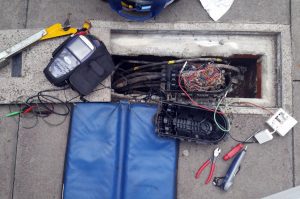ISDN has been the backbone of the business telecommunication network since the 1980s providing service to business of all sizes. Offering far more capacity than analogue lines and faster data connections (prior to the arrival of ADSL) ISDN became the “go to” solution for business telephony.
Available in two flavours, ISND2 worked well for smaller business requiring 2,4,6 or 8 lines with its bigger brother, ISDN30 servicing systems needing between 8 and 30 lines (and multiples thereof). Both versions of ISDN offered the end user greater reliability, more capacity and access to some ground-breaking new features such as Direct Dial Inward (DDI) numbers and Calling Line Inward Presentation (CLIP) or Caller ID as most people know it. And although many switchboard operators resented the arrival of DDI’s, business and the way we communicate with customers changed forever.

For over 30 years, ISDN ruled the (air) waves until the introduction of Voice Over Internet (VoIP). In the early days of VoIP it wasn’t really much of a contender, internet connections were slow and unreliable leading to early adopters suffering from dropped calls and poor call quality. But as speed, stability and availability of internet connections increased and prices decreased VoIP became a more viable option. On-premise phone systems developed into hybrid model being able to accept ISDN and VoIP line services leading to a reduction in the number of ISDN services being installed.
The next big step forward was the introduction of fully hosted, cloud based phone systems which negated the need for an on-premise based phone system all together, in favour of massive data centre based phone systems with users renting a small slice of it on a month by month basis, further accelerating the decline of ISDN systems and their required lines. And with the writing on the wall, many traditional phone system manufactures started to withdraw from the hardware market completely.

Copper networks like the ISDN system and its other analogue siblings are a massive drain on resources for the UK’s main infrastructure provider, Openreach. Copper is expensive, big, heavy, prone to failure and doesn’t like water. It has also attracted unscrupulous gangs of copper thieves, who would think nothing of ripping several tons of cable out of the ground, rendering thousands of customers out of service. Unlike ISDN, data signals needed for VoIP service can run on fibre optic connections. Of course, replacing the nations copper network with fibre is a huge undertaking, both expensive and time consuming, but it has to be done. In 2015 Openreach announced a ten year plan to retire the ISDN/PSTN copper network and get everyone moved to data only connections. They are managing this exchange by exchange with the first stage being to implement a “Stop Sell” directive meaning that if you have an existing copper connection you can continue to use it, but you can’t add or make changes to the service, this will continue until most people have converted, and then by 2025 all services will stop. Users connected to the early exchanges affected have already received their “Notice of service termination”. Indeed, many customers have been told their ISDN lines will cease during 2023
To nudge people in the right direction and to make switching to VoIP more appealing Openreach are implementing a series of price increases to ISDN & analogue services. We’ll all see a significant increase in the wholesale price of copper services this month with another one mooted for the autumn. They are also increasing their service times to respond to copper faults.

So is this the end of the line for ISDN? Yes it is. It’s becoming more less reliable and more expensive. In the immediate short term nobody is coming round with a big pair of wire cutters, but that time is now within sight. Most of our customer base has now migrated to VoIP with only a handful holding one. But as it becomes less reliable and more expensive it’s hard to see how long that view is sustainable. Cost aside, VoIP systems are far more reliable, scalable, flexible and feature rich than the old ISDN systems. Sometimes change is inevitable, and this is one of those times. And it’s far better to manage the process now, rather than wait until it is forced upon you.
If you’re still on the old ISDN or analogue network and you’d like to find out more about switching to VoIP, please get in touch and we’d be happy to help.
This blog post was originally posted on our members own website at https://www.lgnetworks.co.uk



